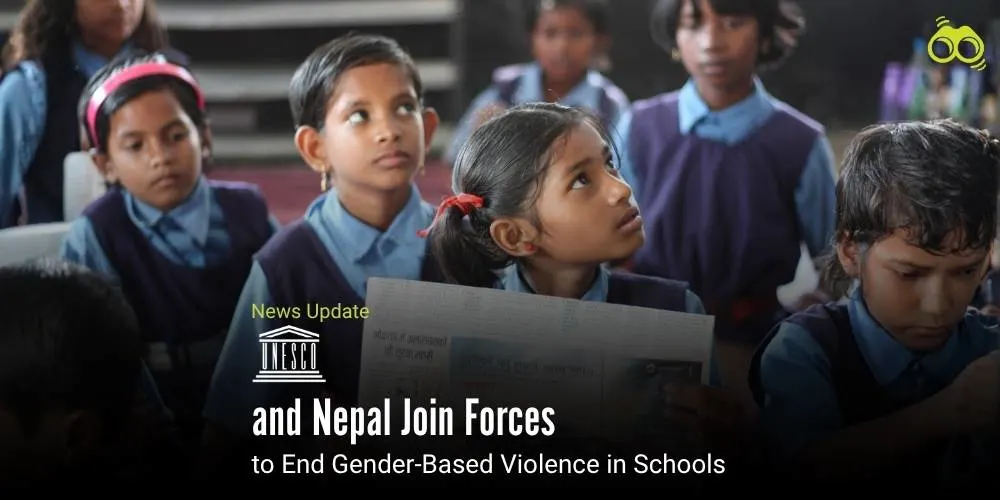UNESCO Supports Equity in Schools Through Targeted SRGBV Interventions in Nepal
How Is Nepal Addressing Gender Inequality in Education? UNESCO’s Programme Shows the Way
In August 2025, Asaman Nepal, the Centre for Education and Human Resource Development, and other UNESCO partners joined a joint mission to address gender-based violence in schools. The Rautami Rural Municipality in Udayapur District and the Sahid Nagar Municipality in Dhanusa District were the focus of this project. These two sites were picked because of their active participation in a UNESCO-supported initiative to create safer and more welcoming learning environments for all students.
By making sure that SRGBV interventions aligned with local education policy and planning, the mission was supposed to improve coordination, collaboration, and local ownership. The National Equity Strategy and Nepal's School Education Sector Plan (2022–2032), which prioritise safety for both teachers and students as well as equity in schools, are closely related to this work. According to UNESCO officials, such a program demonstrates the global commitment of the organisation to SDG 4 Quality Education. It is part of the education for all and lifelong learning by promoting human rights and gender equality. Local governments are encouraged to "own" violence prevention as part of improved, wider school improvement initiatives.
At these community workshops, students apparently said that fears of harassment stopped some from attending school regularly, especially girls. Such dialogues assisted teachers and community leaders to realise that gender-based violence is not only a problem of behaviour but that it also has implications on dignity, safety, and quality education. Most participants noted that, while teasing, bullying, and gender bias are often unrecognised behaviours, they cause a lot of damage as far as students' confidence and learning outcomes are concerned. The program indicated a major impact on teachers, parents, and students. One teacher from Rautamai said that students tend to come regularly to school, express themselves freely, and perform better as long as they feel safe. The initiative will help schools develop such positive behaviours that eliminate the causes of violence in order to create nurturing environments supporting inclusive schools and sustainable development goals for quality education.
Peer-led campaigns and student clubs serve as great tools for promoting respect and inclusion. Both local governments were also said to lend great support to the program with commitments to sustain prevention measures through regular engagement and training for teachers. With this exposure from national representatives, open doors improved relations between central and local authorities. By holding talks such as these, funds and policies were clarified, allowing local leaders to better align their actions with national education goals. Certainly awareness is increasing regarding gender-based violence in schools, but communities have often not developed effective approaches. The mission introduced some practical tools, such as a reporting system, gender-sensitive teaching pedagogy, and ways in which violence prevention can be included in school monitoring.
They walked away with renewed confidence and a clearer sense of direction. A school head from Dhanusa claimed that the initiative was more than just a project; it had come to be part of the culture in the school. Educators and local leaders had shown very strong commitment throughout the Mission in embedding violence prevention into everyday lives within the school environment. They pledged to have these efforts included in education plans, classroom activities, and ongoing teacher training.
The mission exposed huge problems in the schools and within educational systems, such as shortages of teachers, bad infrastructure, and communication barriers between different levels of government. Although none of these problems is a violence prevention issue, they must all be tackled to create sustainable gains and equity within schools. The experiences of Sahid Nagar and Rautamai indicate that it is possible to bring about real, meaningful change when the community, schools, and local leaders work together. Today, these municipalities have become examples of how gender equality and safety, together with quality education, can be made possible for every child through inclusive and participatory approaches.
Editor’s Note:
This mission, with UNESCO and its partners, has proved essential to opening doors for schools in Nepal to be safer and more inclusive for children. This initiative has opened up an area concerning gender-based violence, and not just discipline. It includes dignity, safety, and the right to a quality education for every child. From the editorial point of view, progress is possible when communities, schools, and local leaders work together. This program has done more than raise awareness; rather, it has equipped teachers, parents, and students with tools and gained self-efficacy to bring about change. It reminds us that teacher training, student support, and clear education policy are vital for any long-term change. The alignment of the mission with SG4-Education Quality is of paramount importance. It affirms the fact that under strong coordination and ownership at the local level, the global goals can enter the local classrooms. What the wider issues of teacher shortages, poor infrastructure, poor teacher performance, etc., can do is slow down progress if they go unaddressed. Prevention of violence should be an everyday part of what happens in a school, instinctively considered in teaching styles, school plans, and national education strategies. Commitment from local leaders and educators is hopeful; sustained effort and clear policy direction are still required.
As per Skoobuzz, Nepal is bringing forward a vital message: equitable schools are not a luxury but a necessity for achieving true educational equity. Safety, inclusion, and respect must be treated as core elements of effective learning—not optional extras. This mission has shown that when communities take ownership and embed these values into everyday school life, progress becomes not only possible but sustainable. The path to quality education lies in recognising that dignity and protection are as important as textbooks and exams.
FAQs
1. What is UNESCO doing to stop gender-based violence in schools?
UNESCO, in collaboration with Nepal’s Centre for Education and Human Resource Development and Asaman Nepal, conducted a joint mission in August 2025 to strengthen local efforts against school-related gender-based violence (SRGBV). The initiative focused on improving coordination, local ownership, and the integration of violence prevention into education policy and school planning.
2. How is Nepal addressing gender inequality in education?
Nepal is implementing targeted interventions through its School Education Sector Plan (2022–2032) and National Equity Strategy. These frameworks support inclusive schools and aim to reduce gender bias, bullying, and harassment by embedding equity in schools and education for all.
3. What does SDG 4 say about inclusive and quality education?
SDG 4 Quality Education calls for inclusive, equitable, and safe learning environments. The UNESCO-supported programme in Nepal aligns with this goal by promoting student and teacher safety, gender-sensitive teaching methods, and community-led school improvement strategies.
4. What role do teachers play in preventing violence in schools?
Teachers are central to creating safe and respectful classrooms. The mission highlighted the importance of teacher training in recognising and addressing gender-based violence. Educators were encouraged to adopt inclusive teaching methods and actively support student-led campaigns promoting dignity and safety.
5. How can schools promote gender equality and safety?
Schools can foster gender equality by:
Including violence prevention in education plans
Using gender-sensitive teaching methods
Supporting student clubs and peer-led initiatives
Engaging parents and local leaders in regular dialogue
Implementing clear reporting systems for incidents
6. What practical tools were introduced during the mission?
The mission introduced several tools to support SRGBV prevention, including:
Gender-sensitive teaching strategies
School-level reporting and monitoring systems
Community engagement frameworks
Integration of violence prevention into school improvement plans
7. Which areas in Nepal were involved in the UNESCO programme?
The mission focused on Sahid Nagar Municipality (Dhanusa District) and Rautamai Rural Municipality (Udayapur District). These areas were selected for their active participation in UNESCO-supported efforts to build inclusive schools and improve student safety.
8. What challenges still affect schools and education in Nepal?
While progress has been made, challenges such as teacher shortages, poor infrastructure, and limited coordination between government levels remain. These issues must be addressed to ensure sustainable development goals and quality education are achieved across all regions.
9. How does this mission support education policy in Nepal?
By aligning SRGBV interventions with national education frameworks, the mission strengthens policy coherence and encourages local governments to embed safety and inclusion into long-term planning. This supports both national equity goals and international commitments under SDG 4.














0 Comments (Please Login To Continue)